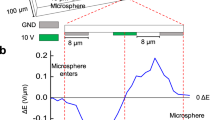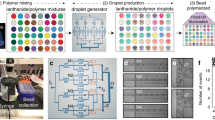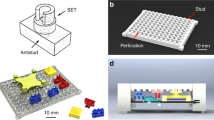Abstract
Encoded particles have a demonstrated value for multiplexed high-throughput bioassays such as drug discovery and clinical diagnostics1,2. In diverse samples, the ability to use a large number of distinct identification codes on assay particles is important to increase throughput3. Proper handling schemes are also needed to readout these codes on free-floating probe microparticles. Here we create vivid, free-floating structural coloured particles with multi-axis rotational control using a colour-tunable magnetic material and a new printing method4. Our colour-barcoded magnetic microparticles offer a coding capacity easily into the billions with distinct magnetic handling capabilities including active positioning for code readouts and active stirring for improved reaction kinetics in microscale environments5. A DNA hybridization assay is done using the colour-barcoded magnetic microparticles to demonstrate multiplexing capabilities.
This is a preview of subscription content, access via your institution
Access options
Subscribe to this journal
Receive 12 print issues and online access
$259.00 per year
only $21.58 per issue
Buy this article
- Purchase on Springer Link
- Instant access to full article PDF
Prices may be subject to local taxes which are calculated during checkout



Similar content being viewed by others
References
Birtwell, S. & Morgan, H. Microparticle encoding technologies for high-throughput multiplexed suspension assays. Integr. Biol. 1, 345–362 (2009).
Wilson, R., Cossins, A. R. & Spiller, D. G. Encoded microcarriers for high-throughput multiplexed detection. Angew. Chem. Int. Ed. 45, 6104–6117 (2006).
Braeckmans, K., De Smedt, S. C., Leblans, M., Pauwels, R. & Demeester, J. Encoding microcarriers: Present and future technologies. Nature Rev. Drug Dis. 1, 447–456 (2002).
Kim, H. et al. Structural colour printing using a magnetically tunable and lithographically fixable photonic crystal. Nature Photon. 3, 534–540 (2009).
Ge, J. et al. Magnetochromatic microspheres: Rotating photonic crystals. J. Am. Chem. Soc. 131, 15687–15694 (2009).
Alivisatos, A. P. Less is more in medicine — sophisticated forms of nanotechnology will find some of their first real-world applications in biomedical research, disease diagnosis and, possibly, therapy. Sci. Am. 285, 66–73 (2001).
Fulton, R. J., McDade, R. L., Smith, P. L., Kienker, L. J. & Kettman, J. R. Advanced multiplexed analysis with the FlowMetrix(TM) system. Clin. Chem. 43, 1749–1756 (1997).
Han, M., Gao, X., Su, J. & Nie, S. Quantum-dot-tagged microbeads for multiplexed optical coding of biomolecules. Nature Biotechnol. 19, 631–635 (2001).
Ma, Q., Wang, X., Li, Y., Shi, Y. & Su, X. Multicolor quantum dot-encoded microspheres for the detection of biomolecules. Talanta 72, 1446–1452 (2007).
Medintz, I. L., Uyeda, H. T., Goldman, E. R. & Mattoussi, H. Quantum dot bioconjugates for imaging, labelling and sensing. Nature Mater. 4, 435–446 (2005).
Braeckmans, K. et al. Encoding microcarriers by spatial selective photobleaching. Nature Mater. 2, 169–173 (2003).
Keating, C. D. & Natan, M. J. Striped metal nanowires as building blocks and optical tags. Adv. Mater. 15, 451–454 (2003).
Nicewarner-Pena, S. R. et al. Submicrometer metallic barcodes. Science 294, 137–141 (2001).
Pregibon, D. C., Toner, M. & Doyle, P. S. Multifunctional encoded particles for high-throughput biomolecule analysis. Science 315, 1393–1396 (2007).
Dejneka, M. J. et al. Rare earth-doped glass microbarcodes. Proc. Natl Acad. Sci. USA 100, 389–393 (2003).
Reiss, B. D. et al. Electrochemical synthesis and optical readout of striped metal rods with submicron features. J. Electroanal. Chem. 522, 95–103 (2002).
Ge, J., Hu, Y. & Yin, Y. Highly tunable superparamagnetic colloidal photonic crystals. Angew. Chem. Int. Ed. 46, 7428–7431 (2007).
Ge, J. & Yin, Y. Magnetically tunable colloidal photonic structures in alkanol solutions. Adv. Mater. 20, 3485–3491 (2008).
Chung, S. E. et al. Optofluidic maskless lithography system for real-time synthesis of photopolymerized microstructures in microfluidic channels. Appl. Phys. Lett. 91, 041106 (2007).
Dendukuri, D., Pregibon, D. C., Collins, J., Hatton, T. A. & Doyle, P. S. Continuous-flow lithography for high-throughput microparticle synthesis. Nature Mater. 5, 365–369 (2006).
Yuet, K. P., Hwang, D. K., Haghgooie, R. & Doyle, P. S. Multifunctional superparamagnetic Janus particles. Langmuir 26, 4281–4287 (2009).
Melle, S., Fuller, G. G. & Rubio, M. A. Structure and dynamics of magnetorheological fluids in rotating magnetic fields. Phys. Rev. E 61, 4111–4117 (2000).
Wilhelm, C., Browaeys, J., Ponton, A. & Bacri, J. C. Rotational magnetic particles microrheology: The Maxwellian case. Phys. Rev. E 67, 011504 (2003).
Pregibon, D. C. & Doyle, P. S. Optimization of encoded hydrogel particles for nucleic acid quantification. Anal. Chem. 81, 4873–4881 (2009).
Acknowledgements
This work was supported by the Korea Science and Engineering Foundation (KOSEF) grant funded by the Korea government (MEST) (No. 2010-0017860 and 2009-0082694) and the System IC 2010 project of the Ministry of Knowledge Economy. We thank A. J. Heinz, W. Park, N. Kim and S. E. Choi for the experimental advice. We gratefully acknowledge Y. Yin at the University of California, Riverside, for valuable input and discussions on particle synthesis.
Author information
Authors and Affiliations
Contributions
S.K. proposed the concept of the work. H.L. and S.K. designed the experiment. J.K., H.K. and H.L. carried out the experiments and analysis. J.K. and J.K. carried out theoretical analysis.
Corresponding author
Ethics declarations
Competing interests
The authors declare no competing financial interests.
Supplementary information
Supplementary Information
Supplementary Information (PDF 1257 kb)
Supplementary Information
Supplementary Movie 1 (SWF 37214 kb)
Supplementary Information
Supplementary Movie 2 (SWF 11558 kb)
Supplementary Information
Supplementary Movie 3 (SWF 24332 kb)
Rights and permissions
About this article
Cite this article
Lee, H., Kim, J., Kim, H. et al. Colour-barcoded magnetic microparticles for multiplexed bioassays. Nature Mater 9, 745–749 (2010). https://doi.org/10.1038/nmat2815
Received:
Accepted:
Published:
Issue Date:
DOI: https://doi.org/10.1038/nmat2815
This article is cited by
-
Organic‒inorganic semi-interpenetrating networks with orthogonal light- and magnetic-responsiveness for smart photonic gels
Nature Communications (2023)
-
Continuous resin refilling and hydrogen bond synergistically assisted 3D structural color printing
Nature Communications (2022)
-
Construction of anti-counterfeiting pattern on the cellulose film by in-situ regulation strategies
Cellulose (2022)
-
Photopatterned microswimmers with programmable motion without external stimuli
Nature Communications (2021)
-
Random access DNA memory using Boolean search in an archival file storage system
Nature Materials (2021)



